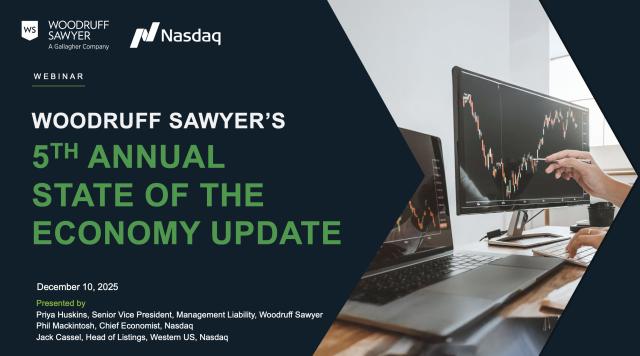Blog
The SEC’s Final Climate Rules in Limbo: Practical Considerations for Boards and Management Teams
After years of threatening to do so, and a vigorous comment period exercise, the Securities and Exchange Commission recently adopted climate-related disclosure rules. Litigation against the SEC has ensued. The new rules will require companies to assess climate-related risk and disclose climate-related risk to a degree that many companies will find costly and burdensome. In this week’s blog my colleague Lenin Lopez provides an overview of the new rules, delineates some of the challenges facing the rules, and provides a set of practical considerations for boards and management teams.
– Priya Huskins
On March 6, 2024, the Securities and Exchange Commission (SEC) adopted final rules that will require public companies to significantly expand the scope of climate-related information in their registration statements and periodic reports.
While disclosures are not slated to begin until 2026 at the earliest, boards and management teams would be well-served to understand what the new rules require, the challenges facing the rules, and the practical considerations that will help establish your good faith effort to carrying out fiduciary duties of oversight related to climate-related risks.
This article will:
- Briefly summarize the SEC’s new climate related disclosure rules
- Discuss notable litigation challenges brought to squash the rules face
- Share practical considerations for boards and management teams

Overview of the SEC’s Final Climate Rules: How Did We Get Here?
The new rules were years in the making. The SEC first issued guidance in 2010 regarding how pre-existing disclosure requirements applied to climate change.
While the guidance didn’t create new legal requirements, it did provide insights into when the SEC might expect a company to disclose the impact that climate change may have on its business. The reaction to that guidance by companies was inconsistent and, in some cases, nonexistent.
Fast forward to 2021 when the SEC issued comment letters to several public companies requesting additional climate change related information.
The SEC even went as far as to share a sample comment letter that contained comments that the SEC might issue to companies regarding their climate-related disclosure or the absence of such disclosure.
As a reminder, the SEC periodically reviews public filings and other disclosures. After such a review, the SEC may request that a company provide additional supplemental information so the SEC can better understand the company’s disclosure, revise disclosure in a document on file with the SEC, provide additional disclosure in a document on file with the SEC, or provide additional or different disclosure in a future filing with the SEC.
In the climate-related comment letters that the SEC issued to public companies in 2021, the SEC often took issue with the disconnect between expansive disclosures some companies provided in sustainability reports posted to their corporate website versus the generally anemic climate change information they included in their public filings.
Why would the SEC wait over a decade after it issued guidance in 2010 to make a real fuss about climate change disclosures?
One thought is that, just a few months before those comment letters were issued, certain investors (looking at you BlackRock) were emphasizing the importance of sustainable investing, which includes managing climate risk.
By the end of 2021, Reuters had published an article titled: “How 2021 became the year of ESG investing.” Ultimately, with the amount of money flowing from climate-minded investors into companies that were touting their environmental, social, and governance (ESG) efforts, the SEC likely wanted to get ahead of “greenwashing.”
In March 2022, the SEC chose to take a more prescriptive approach and issued proposed climate-related disclosure rules. Two years later, on March 6, 2024, the SEC adopted a scaled-back version of those proposed rules.
The SEC chose to adopt a scaled-back version that likely had much to do with the fact that the proposed rules received over 24,000 comment letters, the most for any single proposal in the history of the SEC.
What Do the SEC’s Final Climate Rules Require?
As noted in the SEC's fact sheet accompanying the final rules, the rules require a public company to disclose, among other things:
- Material climate-related risks;
- Activities to mitigate or adapt to such risks;
- Information about the company’s board of directors' oversight of climate-related risks and management’s role in managing material climate-related risks; and
- Information on any climate-related targets or goals that are material to the company’s business, results of operations, or financial condition.
In addition, to facilitate investors’ assessment of certain climate-related risks, the final rules require disclosure of Scope 1 and/or Scope 2 greenhouse gas (GHG) emissions on a phased-in basis when those emissions are material.
Certain companies will also need to file an attestation report covering the required disclosure of their respective Scope 1 and/or Scope 2 emissions, also on a phased-in basis. Further, certain companies will need to disclose the financial statement effects of severe weather events and other natural conditions.
Oh, and if you’re asking how much this all is going to cost, the SEC noted that depending on the company, annual compliance costs (averaged over the first 10 years of compliance) could range from less than $197,000 to over $739,000.
- For a detailed summary of the SEC’s climate rules, see this article from Latham & Watkins.
- For a set of noteworthy Q&A, see this article from Skadden.
- For a comparison of the SEC’s climate rules to California, European Union, and International Sustainability Standards Board (ISSB) disclosure frameworks, see this article from Cooley.
When Do Companies Need to Begin Complying with the Final Climate Rules?
The final climate rules were scheduled to go effective 60 days after publication in the Federal Register. After that date, the compliance was to be phased in over a series of reporting years ranging from 2025 to 2033.
As of the date of this article, however, the effective date of the final rules has been delayed indefinitely. More on that in the next section.
Challenges Facing the SEC’s Final Climate Rules
Within a week of the SEC adopting the final climate rules, petitions and lawsuits were filed challenging the rules. Some argue that the rules exceed the SEC’s statutory authority and others argue that the rules don’t go far enough.
As to the former, the SEC saw it coming. They went as far as to dedicate about 14 pages in the final rules to explain how the rules they were adopting fell within the SEC’s statutory authority.
Apparently those 14 or so pages weren’t enough to ward off challenges. At least nine petitions challenging the new rules were consolidated and will be heard before the conservative-dominated Eighth US Circuit Court of Appeals.
The SEC issued a stay of the final climate rules pending the completion of the Eighth Circuit’s review of the petitions. Further, the briefing schedule, as noted by a recent Gibson Dunn article, has put the viability of the compliance dates into serious question.
Should the climate rules withstand legal challenges, even if in a curtailed form, the SEC will likely need to push the compliance dates out to account for what will be at least monthslong delays.
While it’s unclear whether the SEC will ultimately come out victorious, it’s notable that one of the petitioners, the US Chamber of Commerce, had a recent win against the SEC related to a separate set of disclosure rules, the stock buyback rules.
Would two wins be enough to qualify as a “winning streak”? Or maybe considering the nature of the final rules, it would be a “hot streak.”
Considerations for Boards and Management Teams
So, as the final rules make their way through the Eighth Circuit for review, what should public companies do? Put everything on hold until the court completes its review? Forge ahead and invest in preparing to comply with the final rules?
For many companies, the advisable approach will be to keep an eye on developments in the Eighth Circuit and use this time to take an inventory of what the company is currently doing around climate-related risk assessments, planning, mitigation, and disclosures.
The primary reasons for this: The SEC’s guidance from 2010 remains relevant, and the possibility that climate-related disclosures in public company filings may draw a comment letter from the SEC.
Remember, too, that companies may already be subject to several other climate disclosure regimes, for example various US state disclosure regimes and European disclosure regimes.
In that spirit, what follows are questions boards and management teams can ask as they await the outcome of the Eighth Circuit’s review of the SEC’s final climate rules.
Even in the case that the final rules don’t see the light of day, the following questions are the types that, if asked, can help boards and management teams establish a good faith effort of carrying out their fiduciary duty of oversight of climate-related risks.
Boards
Questions for directors to discuss:
- How do we as a board currently oversee climate-related risks?
- Should we delegate oversight of climate-related risks to one or more board-level committees? Based on our current climate-related risk profile, how frequently do we feel we need to be updated, informed, and/or educated on climate-related matters?
Questions to consider asking management:
- What current processes are in place to assess, mitigate, and monitor climate-related risks?
- When it comes to resource/talent allocation to be able to comply with the new climate-related disclosure rules, does management have what they believe they need?
- What, if any, climate-related risks have the company identified and/or publicly disclosed?
- Any feedback regarding exposure to climate-related risks from our auditors or our insurers?
- Other than the SEC’s final climate rules, are there other similar disclosure requirements that we may become subject to in the future (e.g., California’s new climate disclosure laws)?
Management
Questions for management to discuss:
- What is our current approach to assessing, mitigating, and monitoring climate-related risks?
- What have we publicly disclosed in the way of climate-related risk assessment, planning, mitigation, and disclosure generally?
- What have we publicly disclosed in the way of our climate-related risk governance framework or processes?
- What functional teams are currently involved in those processes, and should we consider including other functional teams?
- Should we form a working group to help with monitoring and complying with climate-related disclosure requirements?
- How do we expect to allocate/budget compliance costs among impacted functional areas (for example, finance, legal, compliance, regulatory, etc.)?
Parting Thoughts
Even if the SEC’s final climate rules were to be scaled back or not survive, there are other disclosure requirements or pressures in the ether that companies may be subject to, as well as litigation risk that makes the practical considerations noted in this article worthy of attention.
Ultimately, it may be a good idea to view this time while the SEC’s final climate rules are in Eighth Circuit purgatory as an opportunity to take stock of current processes and disclosure practices related to climate-related matters.
Author
Table of Contents











